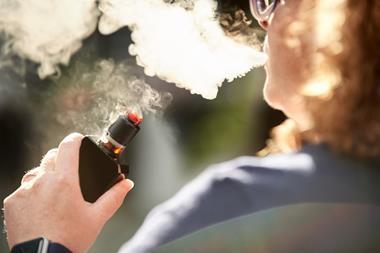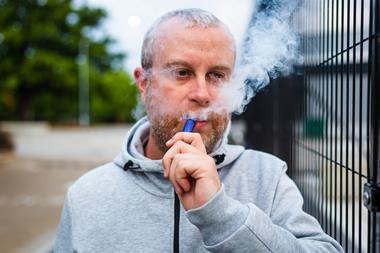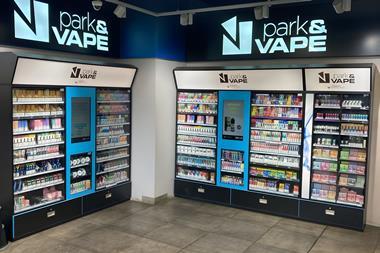The tobacco companies are all in agreement they’re all bitterly disappointed that the government has ignored all the evidence that says a ban on tobacco displays will have no impact on young people smoking. The impact it will have however is on retailers and in a negative way financially in terms of compliance, and logistically in terms of queues of people waiting as staff search for tobacco products that have been hidden away.
On October 12 last year MPs accepted the proposed ban on the display of tobacco products during the report stage of the Health Act 2009. It also opted for a total ban on cigarette vending machines. This Act is applicable to England and Wales.
England
The government has recently ended a consultation period on the proposed tobacco control regulations for England.
The draft regulations include:
the implementation dates for large stores are October 1, 2011 and other businesses on the October 1, 2013. The definition for ’large stores’ has been taken from the Sunday trading laws ie a sales area exceeding 280sq m.
allowing tobacco products to be temporarily shown to adult smokers on request. An A3 size area can be shown at any one time. It will not be an offence for other customers to see the tobacco products if they are being shown to an adult smoker.
restocking will be able to take place during business hours as long as the products are not on display any longer than necessary.
a tobacco product brand name, pack size and the price can be displayed on the closed unit to help staff identify the products.
a price list will be allowed at each till point where tobacco products are sold.
a picture price list can be displayed when requested by an adult smoker.
cash and carries will still be able to display tobacco products and their prices as long as they are in a separate room and cannot be viewed from outside.
Wales
As yet the Assembly in Wales has not published the regulations which will give details of the display restrictions there.
Northern Ireland
The Northern Ireland (NI) Executive has adopted the law laid out in the Health Act 2009 but like Wales has not given details of any display restrictions. On timing, Northern Ireland Health Minister Michael McGimpsey has said that he’s keen to push the display ban through as soon as possible.
On a separate note, the NI Executive recently launched a consultation on increasing the sanctions for those who persistently sell tobacco products to under-18s. The Executive has invited views from retailers and other interested parties on six possible options. These are:1 do nothing. The current sanctions of fines up to £2,500 are a sufficient penalty.
2 registration of tobacco retailers. All retailers who sell tobacco products have to register with a specified agency. This was introduced in the Republic of Ireland last July.3 accreditation. This is a voluntary scheme for retailers.4 a negative licensing system with the removal of the right to sell tobacco for up to a year (the ’three strikes and you’re out’ principle introduced in England and Wales last April).5 a positive licensing system. Retailers would be obliged to apply for a licence before legally selling tobacco products. Obtaining a licence would depend on continued compliance with tobacco control legislation.6 combining a registration scheme with a negative licensing system (this combines options 2 and 4 above).
Retailers have until March 12 to express their views on this consultation.
Scotland
In Scotland, the Tobacco and Primary Services Bill (Scotland) is continuing to make its way through the Scottish parliamentary process and is likely to be voted on shortly. The Bill proposes to ban the display of tobacco products, introduce a registration system for retailers, and introduce fixed penalty notices for retailers who sell cigarettes to under 18s. Scottish retailers still have an opportunity to influence this process by speaking to their local MSPs about the impact on their businesses.
In addition, the Bill includes provision to make proxy purchasing an offence. This would mean that buying cigarettes for minors would be prohibited, plus it would be an offence for anyone under the age of 18 to attempt to purchase tobacco products.
ACS chief executive James Lowman comments: "Much of this Bill is extremely damaging to retailers. However, the focus on proxy purchasing is something that we have been lobbying the UK government to follow suit on and introduce tobacco proxy purchasing laws in England."
It’s easy to assume that the problems of under-age purchases are restricted to more traditional c-store outlets and therefore don’t affect forecourts. However, as JTI’s head of communications, Jeremy Blackburn, points out, you only have to be 17 to drive a car whereas you have to be 18 to buy cigarettes. "There definitely is an age discrepancy there. Plus more and more people are walking onto the forecourt and many rural forecourts have become the village store. So challenging for ID is important for forecourt retailers," he says.
On the subject of the tobacco display ban, Blackburn says: "JTI’s view remains that there is no evidence to suggest the ban will work and it will have unintended consequences ie growth in illicit sales.
"The problem is ease of access to illegal cigarettes, particularly for children. The vendors are already breaking the law so they won’t be challenging youngsters for ID plus the more you prohibit something, the more you drive it underground."
Blackburn definitely has a point as the North West Evening Mail covered a story last autumn about a man selling cigarettes to children from an ice cream van. And a North West Trading Standards survey carried out last year, found that young people had also bought cigarettes from car boot sales, neighbours and market stalls.
Pictorial health warnings
September 30 is the last day of sale for ’other tobacco products’ cigars, roll-your-own tobacco and pipe tobacco without pictorial health warnings (PHW) on the reverse of packs. Until then, retailers are advised to continue rotating their stock to ensure that they sell through those products without PHW.
For more information on any of these tobacco legislative issues, retailers can log onto www.imperial-trade.com or www.tobaccoretailing.com. This latter site includes an interactive tobacco gantry showing examples of display material as well as a training module entitled ’The Law and You’ (see below).
Both JTI and Imperial have sales forces which can help with any retailer queries about products and legislation.
Meanwhile, according to JTI estimates, tobacco sales through forecourts amounted to £1.3bn in 2008 while IGD figures for 2009 state that tobacco still accounts for 31% of total store sales. So despite all the restrictions and bans, it’s a massive category for forecourts.
Standard-priced Lambert & Butler king size continues to be the market leader in forecourts followed by premium brand Marlboro Gold king size.
Iain Watkins, public relations manager at Imperial Tobacco, comments: "The economy-priced cigarette sector within forecourts almost doubled in size in the 12 months ending October 2009. And research by Him carried out last year showed that 23% of adult smokers are buying cheaper cigarettes this represents the equivalent of three million adult smokers. It is important therefore that the growth of this price sector is recognised by forecourt operators and represented on shelf."
Watkins adds that only a year since its launch, the value-for-money JPS Silver range has established itself as a brand that adult smokers are choosing, with over a 3% share of the cigarette market. "The JPS Silver range clearly meets the preferences of those smokers who are continually looking for a value proposition in these continuing tough economic times."
It’s also worth noting that 58% of smokers who choose an economy-priced cigarette go for superkings.
"The price repositioning of Windsor Blue last July has stimulated its growth with Windsor Blue Superkings becoming the fastest growing ’above king size’ brand," adds Watkins.
"But although there is a general trend towards down-trading, Marlboro Gold King Size remains the most popular premium brand and the number two brand in forecourts."
Meanwhile Marlboro Red is, from this month, available in a metallic ’soft pack’ of 20 cigarettes.
From February 15 to March 7, Bestway, Booker and Dhamecha cash and carries are offering retailers £3 off per outer.
The UK launch follows successful introductions in Spain, Greece and Italy.
Zoe Smith, Marlboro marketing manager for UK and Ireland, comments: "This latest innovation introduces a retro feel to this classic brand. By introducing this soft pack we are demonstrating our determination to keep evolving our products to meet the preferences of adult smokers even with established brands like Marlboro Red."
The pack’s metallic finish gives the appearance of a tin with a tactile logo and ’rivet’ design. In addition, the packaging is malleable so it can be continuously reshaped around the contents of the pack and slipped easily into the pocket, making sure the cigarettes remain fresh at all times and are completely protected.
Meanwhile, for forecourt operators to maximise sales, Imperial Tobacco recommends that the space given to a particular brand is in line with sales to reduce out-of-stocks.
"They should also consider their busiest trading times for adult tobacco shoppers and ensure that their tobacco unit is restocked for these important times," says Watkins.
Forties packs are growing in popularity and JTI’s Blackburn puts this down to the fact that people paying for fuel on their credit cards don’t mind putting a couple of packs on their bill too.
At present 20s packs account for 65% of sales; 10s 20% and 40s 8% and growing.
Roll-your-own tobacco (RYO) is another big growth area for forecourts.
According to JTI epos data, the value of RYO tobacco is up 15% year-on-year (2009 versus 2008) across the whole trade but up 20% in forecourts. Blackburn puts this extra growth in forecourts down to retailers stocking a better range and, as a result, giving their customers more choice.
However, Imperial’s Watkins is not convinced that forecourt operators are capitalising fully on the RYO sector.
He says: "They should review their range of RYO products and ensure that the brands they stock meet the preferences of the adult smokers who visit their store.
"In addition it is also important that the RYO segment is prominently displayed reflecting its increased standing within the tobacco category and it is merchandised alongside smoking accessories.
"Golden Virginia continues to be the leading brand in the RYO segment. Down-trading has long been a feature of the cigarette market but it is also now prevalent in RYO. This has seen successful performances by brands such as Gold Leaf.
"Last year we also successfully introduced Golden Virginia Yellow as a lower-priced RYO tobacco which has a smooth blend to meet the preferences of the modern adult smoker. Golden Virginia Yellow has already gained almost a 2% share of sales in forecourts."
Rizla remains market leader in the rolling papers market, with Rizla regular green accounting for over 50% of total sales in forecourts.
Rizla king size slim silver is the biggest-selling king-size paper.
"Rolling papers continue to offer significant commercial opportunities for retailers offering high margins and prompting other purchases such as filter tips and rolling machines," says Watkins.






























No comments yet